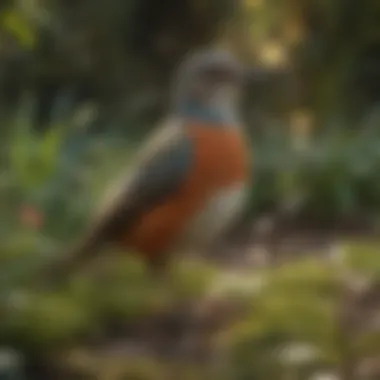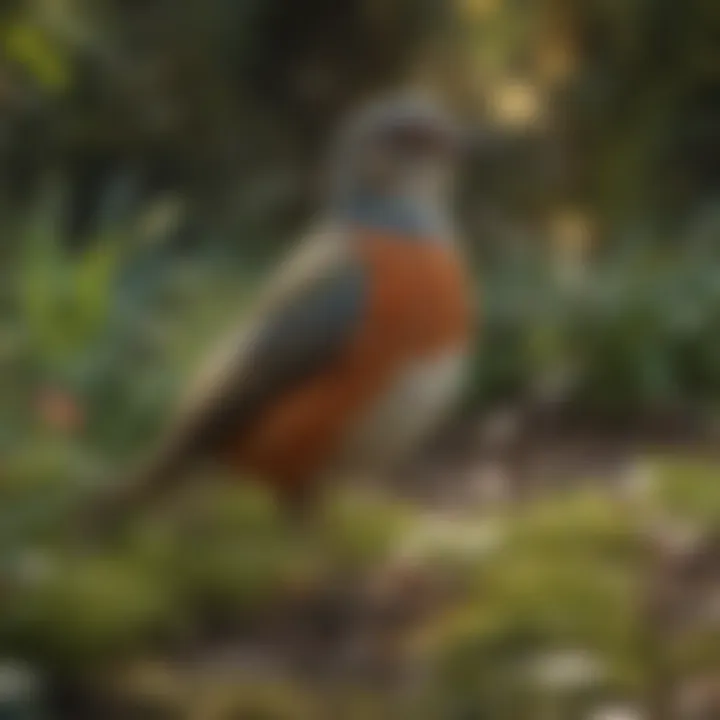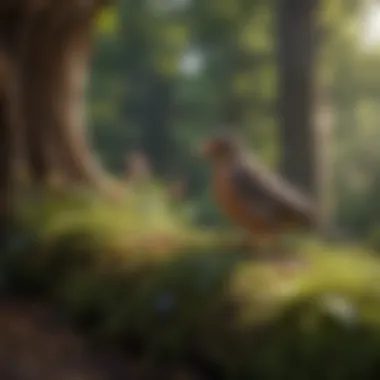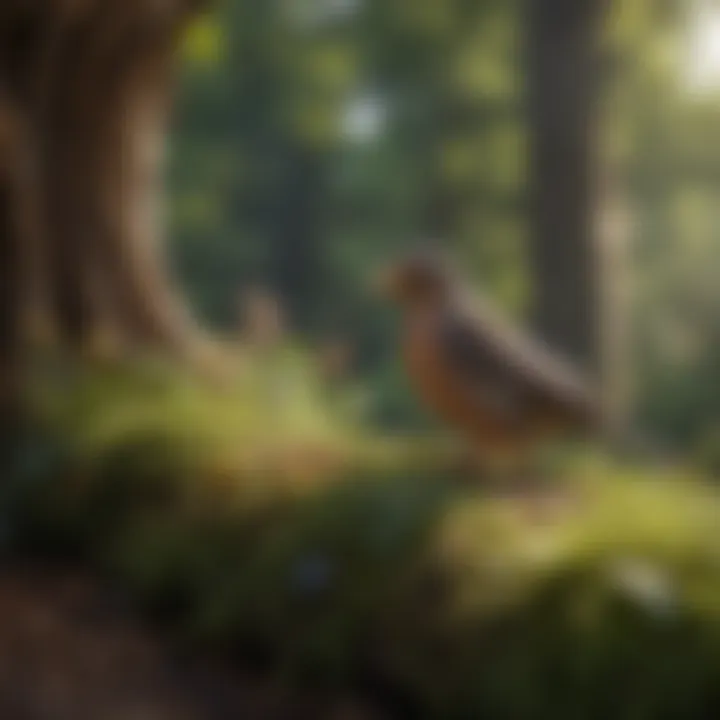Best Garden Bird Deterrents: A Complete Guide


Intro
Gardening is a rewarding activity that many people enjoy, but it comes with its own set of challenges. One such challenge involves birds. While many appreciate birds for their beauty and song, they can become a significant issue when they damage plants or consume crops. This article aims to present effective methods to deter birds from gardens, focusing on ecological balance. By understanding bird behavior and assessing various deterrent strategies, readers can make informed decisions that protect their gardens without harming bird populations.
Understanding the Pest
To manage birds effectively, it is essential to first understand their behavior and life cycle. Knowing which birds pose a threat to your garden helps in selecting the right deterrent methods.
Identification
Recognizing the specific bird species invading your garden is vital. Common culprits include sparrows, pigeons, crows, and starlings. Each species has different feeding habits, nesting preferences, and patterns of behavior. For instance, sparrows often feed in flocks, while crows are known for their intelligence and adaptability.
Life Cycle
Birds generally follow a predictable life cycle involving egg laying, hatching, and fledging. Most birds breed in the spring and early summer. During this time, they require more food, making gardens more vulnerable. Being aware of these cycles allows gardeners to anticipate potential bird damage and implement deterrents effectively before problems arise.
Pest Prevention Strategies
Preventing birds from accessing your garden is the first line of defense. There are several strategies that can be effective.
Environment Modification
Altering the garden environment can make it less appealing to birds. This might include avoiding bird feeders in the garden or removing sources of standing water. Additionally, planting dense shrubs can create barriers that discourage birds from foraging in certain areas.
Physical Barriers
Physical barriers such as mesh netting, bird spikes, or bird wire can physically prevent birds from accessing sensitive areas. Placing netting over fruit trees or vegetable patches can protect your crops without causing harm to the birds. It's essential to ensure that these barriers are installed correctly to avoid trapping birds accidentally.
Control Methods
If preventive measures do not suffice, control methods can be employed. These should be considered carefully to avoid harming the ecosystem.
Chemical Control
While chemical repellents exist, their use should be limited. Many chemicals can have adverse effects on other wildlife or the environment. It is advisable to choose eco-friendly alternatives that do not disrupt the ecological balance.
Biological Control
Introducing natural predator species or utilizing other wildlife-friendly solutions may help manage bird populations. Snakes or certain birds of prey can naturally deter smaller birds from invading gardens. Creating a diverse habitat can encourage a balanced ecosystem that discourages unwanted birds without direct intervention.
"Understanding your avian visitors, their habits and life cycles is crucial for effective garden management."
Ending
Deterring birds from gardens requires a thoughtful approach that respects ecological balance. By employing strategies such as environment modification and using physical barriers, gardeners can protect their plants while minimizing harm to bird populations. When necessary, consider biological control methods and avoid chemicals whenever possible. In a world where biodiversity is essential, it is important to find methods that benefit gardens and the birds themselves.
For further reading on avian behavior and eco-friendly gardening practices, consider sources like britannica.com or community discussions on reddit.com.
Understanding the Need for Bird Deterrents
Bird deterrents serve a significant purpose in maintaining the balance of our gardens. Their primary role is to protect plants from undesirable bird interactions that can adversely affect both the flora and gardening efforts. Understanding the necessity of bird deterrence is critical for gardeners looking to preserve their plants without causing harm to the bird populations.
Ecological Impact of Birds on Gardens
Birds are often seen as a natural part of a garden's ecosystem. However, their presence can lead to several issues. For instance, some species may feed on seeds, fruit, and even delicate buds, resulting in considerable crop loss. Different birds have different eating behaviors, with some being more destructive than others. The ecological impact of birds can be quite profound, as overpopulation or invasive species may lead to diminished plant health, challenging the gardener's objectives.
Moreover, the imbalance in bird populations can also disrupt local ecosystems. When certain birds flourish unchecked, they may outcompete native species for food and nesting sites. This change can negatively affect biodiversity in an area, making it essential to monitor and manage bird populations in gardens.
Benefits and Drawbacks of Bird Presence


The presence of birds in a garden offers both advantages and disadvantages. On the plus side, birds act as natural pest controllers, feeding on harmful insects that could damage plants. Their activities can contribute to pollination, thereby enhancing the health of various plant species. Some gardeners also find joy in observing birds, which can add aesthetic and emotional value to their gardening experience.
However, the drawbacks often become more apparent when gardens experience damage from feeding birds. These birds can strip plants of their fruits and seeds, leading to lower yields. Additionally, some bird species are known to be particularly aggressive, which can make gardening less enjoyable.
Ultimately, finding a balance between enjoying the benefits of bird presence while mitigating the drawbacks is key. Understanding these aspects is vital for those looking to create productive and sustainable gardens. The use of effective bird deterrents can empower gardeners to protect their plants while still appreciating the beauty and utility birds bring to the environment.
"Managing the bird presence effectively can lead to healthier gardens and happier gardeners."
By examining the need for bird deterrents, it becomes clear that a thoughtful approach can yield a flourishing garden while respecting the role of birds in the ecosystem.
Identifying Problematic Bird Species
Understanding which bird species can become problematic in gardens is vital for effective management. Different birds exhibit a range of behaviors and preferences that can significantly impact gardens. Recognizing these species helps gardeners to develop targeted strategies for deterrence, reducing damage to plants while respecting bird populations.
Common Birds That Damage Gardens
Several bird species are notorious for causing harm to gardens. Common culprits include the European Starling, House Sparrow, and American Robin. The European Starling, for instance, often feeds on fruit, damaging plants in the process. Its large flocks can also lead to a general degradation of garden aesthetics.
House Sparrows are another concern. They are known to invade birdhouses and feed heavily on seeds, which can deplete the food supply for other birds. American Robins can also cause issues by pecking at seedlings and ripe fruits. Understanding their feeding habits and nesting behaviors can provide clues on how to mitigate their impact effectively.
- European Starling: Often feeds on fruits and can gather in large numbers.
- House Sparrow: Consumes seeds and occupies birdhouses, leading to resource depletion.
- American Robin: Known for damaging seedlings and consuming ripe fruits.
Behavioral Patterns of Garden Birds
Birds have distinct behavioral patterns that influence how they interact with gardens. Observing these patterns helps in anticipating possible damages and deciding how to effectively intervene.
For example, many birds tend to feed during the early morning and late afternoon. This information is crucial when placing deterrents. If deterrents are introduced during peak feeding times, they might be less effective. Additionally, some birds are more prone to nesting in certain types of vegetation, which can be valuable insight for gardeners looking to protect their plants.
Understanding environmental factors is also important. Birds often react to changes in their surroundings, including the introduction of new plants, which may attract them. By being aware of these behaviors, gardeners can shed light on how to anticipate avian activity and act proactively.
"Identifying problematic bird species is the first step in creating a balanced garden environment that minimizes bird-related damage while maintaining ecological integrity."
In summary, recognizing bird species and their behaviors is a foundational element in managing a garden effectively. This knowledge enables the selection of appropriate deterrents while ensuring that bird populations are respected.
Evaluating Deterrent Options
The process of evaluating bird deterrent options is essential in achieving a balance between protecting gardens and not harming bird populations. It involves assessing various methods to figure out which one or several best suit the gardener's needs and the specific situation of the garden. Considerations such as effectiveness, cost, and ecological impact are vital when choosing deterrents. A thoughtful approach can lead to a more sustainable gardening environment.
Visual Deterrents and Their Effectiveness
Visual deterrents use sight to scare birds away from gardens. These can be effective in reducing bird activity, as birds often rely on their vision to detect safety and food sources. Visual deterrents also come in various forms, each with unique properties and characteristics.
Scare Tactics Using Reflective Surfaces
Scare tactics that utilize reflective surfaces are popular due to their simplicity and effectiveness. Reflective surfaces can confuse and deter birds, as they produce unpredictable flashes of light. These can include shiny materials like aluminum foil or reflective tape. One of the main advantages of these scare tactics is that they are cost-effective and easy to install. However, the disadvantages include potential habituation; birds may become accustomed to the flashes over time. Proper placement and rotation can help mitigate this issue.
Decoys and Their Impact
Using decoys is another effective visual tactic. These include fake predators or other threatening objects. The presence of decoys can make birds feel unsafe, encouraging them to avoid the area. A common choice is using owl or hawk figures, as these predators are naturally feared by smaller birds. While decoys can be beneficial, it's important to place them strategically. A major disadvantage is that if not moved frequently, birds may recognize that the decoy is stationary and safe, diminishing its effectiveness.
Colors and Patterns that Deter Birds
Colors and patterns play a significant role in bird deterrence strategies. Specific colors can create an association with danger for birds, especially bright or unnatural colors. Some gardeners use colors like orange or bright yellow to signal that an area is unsafe. The uniqueness of this approach lies in its ability to blend with other deterrents. However, the downside is that the visual impact may not be strong enough against all types of bird species, which requires careful observation and adaptation.
Auditory Deterrents Explained
Auditory deterrents utilize sound to ward off birds from gardens. These methods are based on avian fear responses. By understanding bird behavior, gardeners can effectively implement auditory techniques.
Noise Devices: Pros and Cons
Noise devices can deter birds by generating sounds that are unpleasant or alarming to them. They include devices that emit loud noises or sounds of predators. The major advantage here is that noise can be more effective against certain bird species that are sensitive to sound, potentially covering larger areas compared to visual deterrents. On the downside, noise devices can become annoying for humans as well, and their effectiveness may decrease over time as birds habituate to the sounds.


Biological Calls as Deterrents
Another auditory method uses recorded biological calls of birds' predators. The idea is that the call of a predator invokes a natural fear response, prompting birds to flee. This technique takes advantage of the inherent instincts of avian species. However, like noise devices, such calls may lead to habituation, and not all birds respond uniformly. Determining the right call for the specific bird population in the garden is crucial for success.
Physical Barriers and Netting
Physical barriers provide a more direct approach to stopping birds from accessing plants. These can be very effective in protecting specific areas without causing harm. Depending on the garden's layout and plant types, various types of barriers can be implemented.
Building Effective Enclosures
Building enclosures can physically block birds from plants. These can include netting or frames that cover garden beds. This method is particularly favorable because it can offer 100% protection against feeding birds and doesn't rely on adaptation processes from the birds. One significant disadvantage is that they can be more expensive and require maintenance, especially in adverse weather conditions.
Selecting Appropriate Materials
The materials selected for barriers significantly affect their effectiveness. Gardeners must choose materials that are sturdy enough to withstand weather and bird activity. Common materials include plastic netting, metal mesh, or heavy-duty fabric. Each has its pros and cons, such as durability versus visibility. Choosing the right material can make a substantial difference in terms of cost and longevity of the deterrent solution.
Innovative Approaches to Bird Deterrence
Finding effective bird deterrents is essential for maintaining the health of gardens without harming avian species. Innovative approaches incorporate technology and eco-friendly practices to create solutions that are not only effective but also considerate of the environment. This section examines some of these modern methods, exploring how they can complement traditional strategies to create a more balanced ecosystem in gardens.
Technological Solutions for Bird Deterrence
With advancements in technology, homeowners can utilize a range of devices designed to deter birds safely and effectively. These electronic solutions offer both precision and efficiency, allowing for targeted deterrence that doesn’t negatively impact other wildlife.
Motion Sensors and Sprinklers
Motion sensors paired with sprinklers are one of the more popular choices among gardeners for deterring birds. They work by detecting movement within a specific range and activating a burst of water. This sudden spray is both startling and effective, causing birds to associate the area with an unpleasant experience.
The rapid response of motion sensors provides a highly responsive deterrent. Many homeowners appreciate this feature because it requires minimal input after the initial setup. However, maintenance is still required to keep the sensors and sprinklers functioning properly, which can be a slight drawback. Despite this, the ability to customize settings for various bird species adds significant value to this approach.
Ultrasonic Bird Deterrents
Ultrasonic bird deterrents operate by emitting high-frequency sounds that are unpleasant to birds but imperceptible to humans. These sounds can be an effective tactic, particularly for species sensitive to noise. Such devices have gained traction because they do not have physical mechanisms that can be seen or observed, making them a discreet option.
One key characteristic of ultrasonic deterrents is their ease of installation. They can typically be plugged in and left to operate without much further involvement. However, some users report variable effectiveness, as not all bird species react to ultrasonic frequencies the same way. Thus, while these devices can be beneficial for targeting certain species, their general effectiveness may vary.
Using Eco-Friendly Products
The push for sustainability extends to bird deterrent solutions as well. Eco-friendly products not only help maintain a garden’s integrity but also ensure that surrounding wildlife is treated with respect. Employing these methods can contribute to a greener gardening practice while effectively managing bird populations.
Organic Sprays and Their Effectiveness
Organic sprays represent a more natural deterrent that can effectively discourage birds without resorting to harmful chemicals. These sprays typically use essential oils and other natural ingredients that have an unpleasant smell or taste for birds, making them a practical solution for homeowners.
Their application is straightforward, appealing to those who prefer less invasive methods. Many users find success in keeping birds away without damaging plants or the environment. Nevertheless, the effectiveness of organic sprays can diminish over time and may require frequent reapplication, particularly after rainfall.
Biodegradable Deterrent Options
Biodegradable deterrents offer another eco-friendly avenue for bird management. These products consist mainly of natural ingredients that break down without leaving harmful residues in the soil or water. Such options appeal to environmentally conscious gardeners looking to blend protection with sustainability.
One notable feature is their minimal environmental impact, allowing for guilt-free usage. Still, like organic sprays, these deterrents may necessitate more frequent applications, which can be a consideration depending on the garden’s exposure to weather elements.
"Innovative deterrent solutions combine technology and eco-friendliness to protect gardens while keeping ecological balance intact."
By exploring these innovative approaches, gardeners can not only enhance the health of their gardens but also contribute positively to the surrounding ecosystem. Understanding the effectiveness and limitations of these methods allows for informed decision-making, ensuring that garden management remains responsible and impactful.
Implementing Bird Deterrents in Your Garden
Implementing bird deterrents in your garden is a crucial step for maintaining a flourishing outdoor space. When birds invade our gardens, their foraging and nesting habits can harm delicate plants and threaten the balance of an ecosystem. Choosing the right deterrent is not simply about keeping birds away; it is also about doing so in a manner that is ethical and environmentally conscious. Effective implementation could mean the difference between a thriving garden and a devastated one.
Moreover, using bird deterrents can save time and effort spent on plant replacement or restoration. Here, you can explore different aspects that influence the effectiveness of deterrents. This section will delve into their strategic placement and how timing greatly impacts their success in deterring birds.


Strategic Placement of Deterrents
The arrangement of deterrents within your garden can determine how successful they will be. When placing deterrents, consider visibility, approach paths of birds, and psychological impact.
- Assess Vulnerable Areas: Identify the spots in your garden most susceptible to bird damage. These areas include vegetable beds, flower patches, or new plantings. Position deterrents closer to these vulnerable sections.
- Height and Angle: Install visual deterrents at varying heights. Birds often fly from above, so placing items like reflective tape or wind chimes at different levels can maximize visibility. Additionally, place deterrents at angles that face toward potential bird landing areas.
- Frequent Movement: Moving deterrents periodically can confuse birds. If they sense a change in their environment, they may think twice before approaching. This technique includes relocating decoys or rearranging physical barriers.
- Natural Elements: Incorporating natural elements, like native plants that are unappealing to particular species, can work harmoniously with artificial deterrents. This can enhance your garden's protective barriers without being overly obtrusive.
Timing and Seasonal Considerations
The timing of when to implement bird deterrents can significantly influence their effectiveness. Different birds have varying migration patterns and breeding times, which necessitate a careful approach:
- Spring Preparation: During the spring, birds begin nesting and may look for food. Introducing deterrents just before this season can prevent them from becoming comfortable in your garden.
- Seasonal Adjustments: As seasons change, so do bird behaviors. For instance, in summer, certain birds might become more aggressive in their search for food. Adjusting your deterrents to counter these shifts can help.
- Weather Related Timing: Rainy days or windy weather can reduce the efficacy of some deterrents, especially visual ones. Monitoring weather conditions can help you decide when to activate or enhance specific strategies.
"Effective implementation of bird deterrents requires thoughtful planning and adaptability to ensure that your garden flourishes while coexisting with nature."
Finally, regularly monitoring the effectiveness of your deterrents throughout the seasons will inform future adjustments. Taking into account both strategic placement and timing allows you to create a well-rounded approach to bird deterrence that can lead to greater gardening success.
Monitoring Bird Deterrent Effectiveness
Monitoring the effectiveness of bird deterrents is crucial for any gardener striving to maintain a healthy and thriving garden environment. This process goes beyond merely installing these deterrents; it requires ongoing assessment and adaptation of strategies to ensure that they deliver the intended results. Effectively monitoring helps in understanding which deterrents work best in specific contexts, ultimately leading to better garden management.
Assessing Impact on Bird Behavior
Evaluating the impact on bird behavior involves observing changes in both the presence and interaction of birds within the garden. This can include noting reductions in bird visits or altered feeding patterns. Recording data on bird sightings before and after the implementation of deterrents is an ideal way to measure success.
Some actions to consider:
- Keep a log of bird species encountered before and after the deterrents are set up.
- Use camera traps to monitor frequencies of visits to the garden.
- Look for signs of damage on plants to correlate with bird activity.
This careful observation helps in identifying the most effective strategies, allowing adjustments as needed.
Evaluating Plant Health Post-Deterrent Installation
After implementing bird deterrents, assessing the overall health of the plants becomes essential. Healthier plants indicate that the installed deterrents are working effectively against problematic bird species. Key indicators of plant health to monitor include:
- Leaf condition: Check for signs of nibbling or damage.
- Growth patterns: Observe if plants are growing as expected without interference.
- Fruit yield: Particularly in fruit-bearing plants, note any improvements in quantity and quality.
Regular checks will reveal whether the installation of deterrents has positively influenced plant health. If plants continue to suffer, it may indicate the need for a different approach or combination of deterrents. This continuous evaluation connects the deterrent strategies to the ecological health of the garden.
"Effective monitoring of bird deterrents not only protects gardens but also fosters a deeper understanding of local bird behaviors."
Ethical Considerations in Bird Deterrence
Understanding the ethical implications of using bird deterrents is crucial for anyone who engages in gardening. As people seek methods to protect their gardens from damage caused by birds, it is essential to consider the impact of these methods on the birds themselves and the overall ecosystem. Ethical bird deterrence promotes the idea of finding a balance between safeguarding one's plants and preserving bird populations. Each decision made regarding deterrents should be modulated by a comprehensive understanding of avian behavior, habitats, and their significant role in the local ecology.
Understanding Bird Behavior and Habitat
Birds are an integral part of the garden ecosystem. They influence plant health through their feeding habits and pest control. Understanding the behavior of birds, including their feeding, nesting, and migration patterns, aids in crafting effective deterrence strategies. For instance, knowing the type of food that attracts certain species can help gardeners identify how to keep them away from valued plants. Additionally, recognizing the habitats that birds favor can inform placement of deterrents. Reducing access to preferred areas may lead to less damage without harming the birds or altering their ecosystems excessively. By fostering a deeper awareness of avian habitats, gardeners can align their deterrent methods with the natural tendencies of the birds rather than fighting against them.
Balancing Deterrence and Conservation Efforts
The challenge lies in implementing bird deterrents that do not contradict conservation efforts. Many bird species are experiencing population declines due to habitat loss and environmental pressures. Selecting humane deterrents is essential in this regard. For example, instead of using lethal approaches, employing physical barriers, such as netting, provides protection for gardens while allowing birds to coexist in their environment. Likewise, it is important to use techniques that naturally repel birds without causing harm or stress. This could include the use of reflective materials that disturb their vision rather than creating a hostile environment.
A consideration for eco-friendly deterrents also emerges; organic options and biodegradable materials can minimize the ecological footprint of gardening practices. The goal should be to deter without destruction. As stewards of the environment, gardeners have a responsibility to safeguard plant life while also respecting avian species and their crucial role in the ecosystem. By carefully crafting an approach to deterrence, one can enjoy a flourishing garden without undermining the delicate balance of nature.
Finale
Key Takeaways on Effective Bird Deterrence
- Integration of Different Methods: Employing a combination of deterrent strategies often yields the best results. Visual deterrents may work well combined with sound devices.
- Monitoring Impact: It is vital to take notes on the effectiveness of each deterrent. Observing changes in bird behavior or plant health can guide future deterrent choices.
- Consideration of Non-Invasive Approaches: Choosing eco-friendly and non-invasive methods ensures that we protect bird species while safeguarding our gardens.
Future Trends in Bird Deterrent Technologies
As technology advances, new solutions for garden bird deterrents are emerging. Some trends to watch for include:
- Smart Deterrents: Devices that incorporate sensors to detect bird presence and activate deterrents in real time are becoming more widespread.
- Biological Innovations: More research into using harmless organic compounds to repel birds without harming them is likely to arise.
- Hybrid Models: Combining different types of technologies (for example, visual and auditory) will increase effectiveness and cater to a broader range of bird species.
Incorporating these elements allows for a comprehensive approach to managing birds in gardens. This guide serves as a valuable resource for readers, enabling them to make informed decisions, prioritize their gardening needs, and ultimately achieve a healthier garden environment without adversely affecting bird populations.







